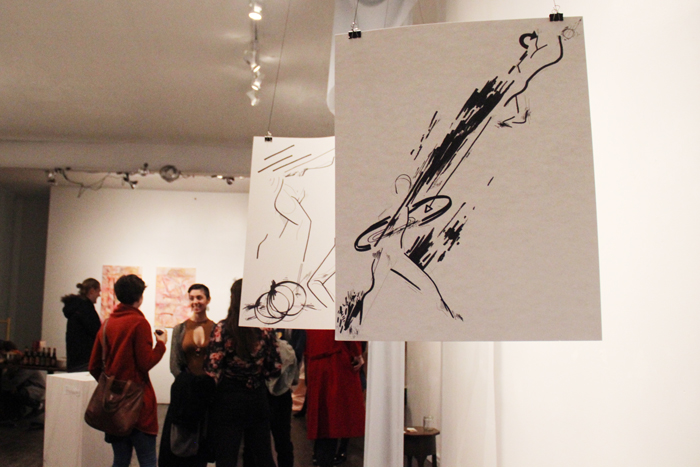To think of dance purely as footwork is to underestimate the scope of the expression. To dance is to move, and to move can be interpreted in a variety of ways. On Feb. 23, the Alegria Contemporary Ballet Company, the only one of its kind at McGill, presented MOVE, a collaboration between fine artists, dancers, and even audience members. Alegria’s project stretched the bounds of dance, as the participating philosophers explored the meaning of movement.
Representative of the informal connections among members of the art community at McGill, five local artists (Sarah Ballentine, Flloral, Alissa Zilber, Olivia McFarlane, and Sivan Rotchin) had previously been invited to interpret Alegria rehearsals. Rapt in the tireless practice and echoing the personal approach that Alegria seeks to cultivate, each painter drew unique inspiration from the dances. The ballet company acted both as the muse and the audience, as MOVE marked their first time seeing the painters’ products.
Paintings and multimedia art pieces were displayed around the room, with audience members and Alegria dancers free to move around. The dancers were quick to incorporate the artistry into their work. Of particular interest were several hanging shrouds of blush-coloured fabric, with Alegria performers using them as props—entwining with them as they danced. Conceptualized by Ballentine, these veils represented the gentle flow of dance. At one end of the room stood a pair of paintings in shades of red, alongside graphic instructions for dancing “The Bunny Hop.” At the other end, works of art included streamlined dashes of Japanese ink, a surprise appearance of Spirited Away character “No Face,” and a series of black-and-white stills of the dancers performing—their black leotards sharply contrasted their paler skin while pictured in increasingly contorted positions.
Although MOVE was an interdisciplinary and interactive experience, the dance performance was the main event of the night. The dancers improvised, taking to the stage in the spur of the movement. There was no formal schedule or announcements. The start of each performance was signaled by a hush falling over the room. In turn, the dancers treated the entire room as their stage, through which audience members were free to roam around as they wished.
Although they regularly mingled with the spectators throughout the evening, the performers demonstrated unshakable concentration during their routines. Some played off one another others formed their own path; some moved in a precise, calculated fashion; others were more sporadic. All moved with a consistent personal narrative. Having been thoroughly inspired, by the end even audience members were moving in tune alongside the company.
Overall, the occasion conveyed a surreal atmosphere. Artists and dancers emanated grace, and the individual parts smoothly came together. Eden Schwartz, the event coordinator of the night, felt that MOVE accomplished its goals of hosting an innovative performance and inspiring participants.
“As I walked around the gallery I heard people talking about the art and movement and dance,” Schwartz said. “[….] I truly hope that everyone there, those who consider themselves artists and those who don’t, were inspired to go out and create!”








